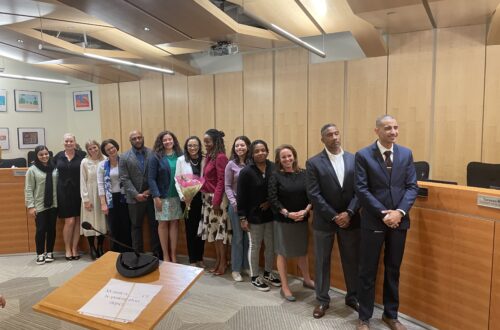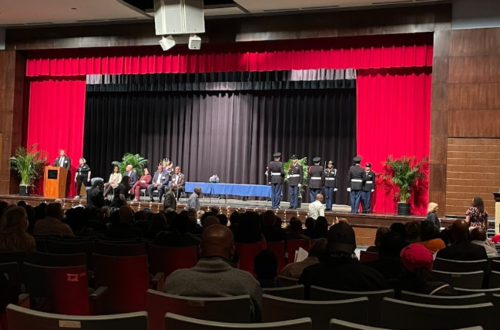A Dead Language, A Dying Class
Nora Malone
Editor
“Three of the same or two of two:” we’ve all heard it— the dreaded language requirements needed to graduate. And students are not lacking in options: Spanish, French, German, Chinese and Latin. Most of these departments have multiple teachers, but the two smallest, Latin and Chinese, have only one.
Alexandria City High School’s Latin teacher, Justin Redpath-Dascola, has been working at ACHS for 13 years. For all but three of those, he has been the sole teacher in his department— a department that has struggled more than the rest with sustaining regular enrollment.
“It really fluctuates,” said Redpath-Dascola. “But overall, it has decreased.”
Currently, ACHS offers six levels of Latin, with level 5 being Advanced Placement (AP) Latin. For years, enrollment numbers have been low or nonexistent in the higher levels (Latin 4+) since many students stop taking languages after their language graduation requirements are fulfilled, so Latin 4, AP Latin and Latin 6 have been combined in one class for years. However, the upper levels are not the only Latin classes struggling with enrollment.
“Last year in Latin 1, we had about 20 students, which is a nice size. But only 7 people came over [into Latin 2 this year],” he said.
This drop in numbers meant that Redpath-Dascola was asked to combine two of his low-enrollment classes (on top of the combined Latin 4, AP and 6 class) and teach an additional non-Latin class— general English 12. This is an inclusion he would have been fine with if not for the difference between his class load and that of the middle school teachers.
“If I look back at my middle school colleagues, one of those teachers has a total of five students—between all three grades— and the other one had a total of 20-25 students,” he said. “And I’m looking at them thinking, ‘How come they get to have such low numbers and just teach one subject?’”
The decreasing enrollment has not only added an English class to Redpath-Dascola’s schedule but has led to different language levels being combined into the same class. With the upper levels, this is not uncommon.
Redpath-Dascola is used to organizing his classes this way, making them independent work focused.
“The students who go into AP or Latin 6 should be able to handle things on their own anyway because they’re just that advanced,” said Redpath-Dascola.
However, the new combination of Latin 1 and 2 has been more of an issue.
“When [administration] came to me in the middle of last year after students had signed up for classes, they showed me my numbers of enrollment. I said to them exactly, ‘Whatever you do, don’t combine Latin 1 and 2, because those are the levels that need the most individualized attention.’ And that’s exactly what they did,” said Redpath-Dascola.
Students in lower levels need more help because they’re just starting the language, and Redpath-Dascola says he is trying his best to adapt and make it work. He divides the class in half, first setting up the Latin 2 students with independent work then going over to teach the Latin 1 students. Midway through the class, he switches. His goal is to give each group an equal amount of time, but he says it’s difficult to feel like he’s doing enough.
“It’s really frustrating because there’s a lot more I know I could be doing for both of those groups, and I feel like it’s really unfortunate because they are the two lowest levels where you need to give them the most help and direct instruction,” he said.
Behavior in these combined classes has also been an issue.
“[When] I see [Latin 1] kids off task and I’m with the Latin 2s, then I have to interrupt [their work] and go address the Latin 1s and get them back on track,” he said.
Redpath-Dascola especially has issues with students who don’t have a lot of personal drive.
“I try to go back over to them and give them some encouragement and guidance and try to talk them through whatever they need to be doing, but that takes more time away from the other level,” he said.
Another issue Redpath-Dascola has is losing students after middle school. Students can only reach Latin 2 by the end of 8th grade, and many choose to not continue in high school.
“I really want to look back at the middle schools and see what their programs are like,” said Redpath-Dascola.
Years ago, students in middle school spent their 6th grade years getting introduced to all the languages offered, and then in 7th grade, they each choose a class and begin learning that language.
“That’s how it was in the beginning, and [the language department] was really well balanced, and we had a really strong Latin program. I’d love to see that come back,” Redpath-Dascola said.
While the department is experiencing difficulty gaining and retaining students, those who stay are dedicated, driven and willing to lose some of their one-on-one time with the teacher.
“I think we have a lot of ambition, and I would love to see the program more populated,” he said.
Featured photo by Chloe Yokitis for Theogony






